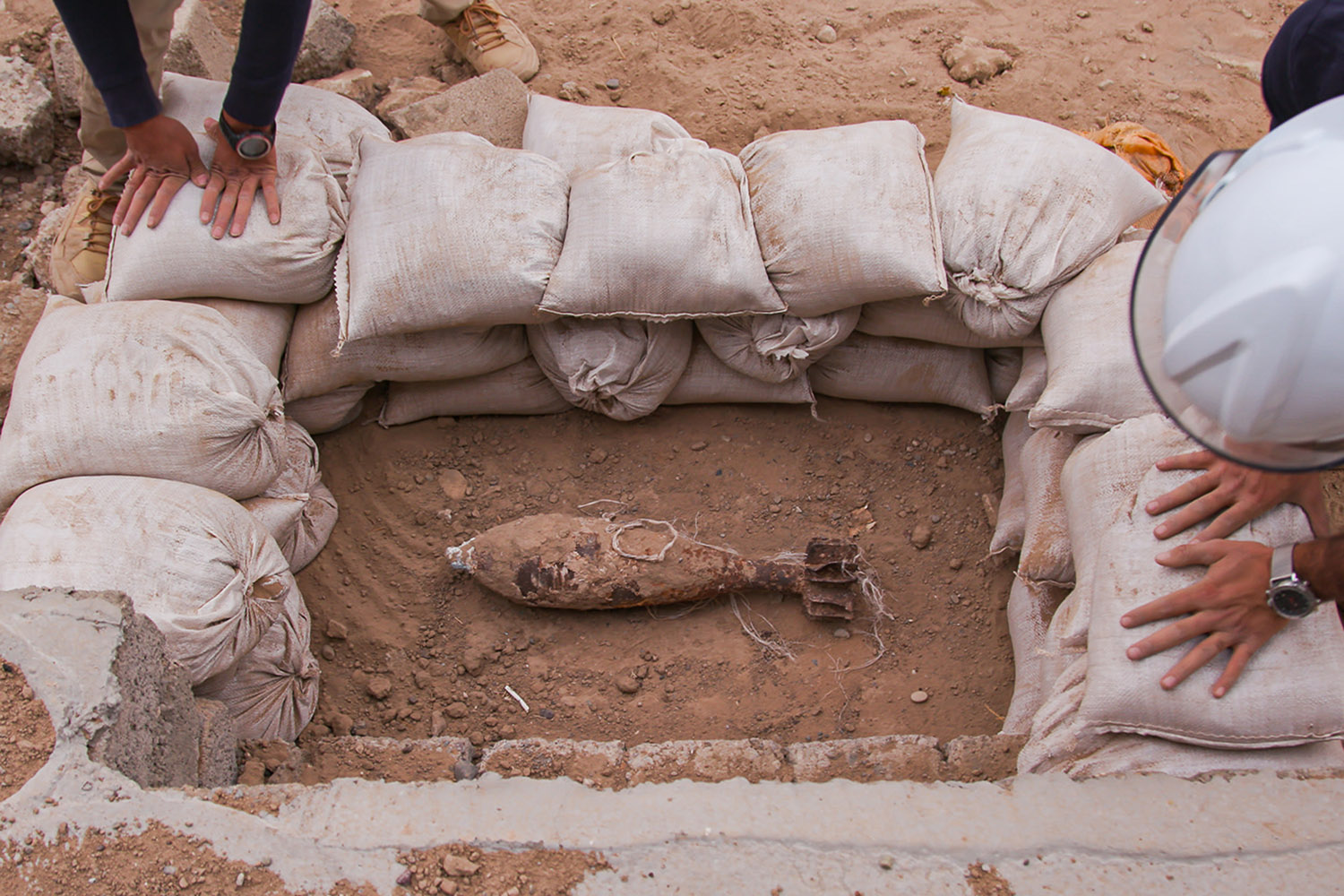15/02/2022 Iraq
“If you ever come across anything suspicious like this item, please do not pick it up, contact your local law enforcement agency for assistance”
By Jack Losh, a journalist, photographer and filmmaker covering conservation, humanitarian issues and traditional cultures, often in areas of conflict and crisis.
Like the neck of a giraffe, a minesweeping vehicle extends a serrated bucket forward and dips its teeth into the blighted earth. It drags the dry soil backward, sifting, before harvesting a jerrycan and gently placing it on the edge of a field. This is no harmless piece of trash; the container holds 20 liters (or around 5 gallons) of explosives—enough firepower to kill multiple people and wreck an armored vehicle. Nor is it a rarity. All around, a vast field is filled with dozens of fluttering ribbons attached to small yellow posts, each one placed where another bomb once lay. In total, a staggering 700 improvised explosive devices (IEDs) have been pulled out of this arid field by the Halo Trust, a humanitarian organization that clears land mines and other explosive debris. Those weapons are just a fraction of the tens if not hundreds of thousands of IEDs laid across Iraq by the Islamic State during its reign of terror. Here in Baiji, an industrial town in the Salahuddin province between Baghdad and Mosul that was ravaged by fighting, dense belts of the buried bombs fan out from a nearby oil refinery, the country’s largest and a site once jealously guarded by Islamic State fighters. They placed IEDs every three to five meters from each other,” said Halo Trust team leader Omar Hussam, looking out over a field that took 10 months to clear. “There are many, many areas with the same density as here.” These indiscriminate weapons, along with unexploded shells and minefields from earlier wars, have made Iraq one of the world’s most explosive-littered countries in the world. Like ash from a volcanic eruption, repeated flare-ups of conflict over the past few decades have left explosives strewn across swaths of the country. To the south, legacy minefields and unexploded cluster munitions were left by the 1980s Iran-Iraq War, the 1991 Gulf War, and the 2003 U.S.-led invasion. Exacerbating the problem is the unprecedented, industrial-scale use of IEDs by the Islamic State to the north in addition to the large quantities of mortars and artillery shells fired by both jihadi and pro-government forces. The problem with using explosive weapons in populated areas is not only can they kill, injure, traumatize, and displace the population, but their temperamental design and inaccurate use mean many fail to explode on impact. That legacy can threaten civilians years after a conflict has ended, setting in motion a vicious cycle. Their persisting presence impedes economic development and the return of refugees while hindering access to health, education, and other essential services. Across Iraq, more than a quarter of explosive ordnance contamination is found in agricultural areas, preventing farmers from using the land or making a living. Another fifth is found in infrastructure, hampering reconstruction efforts and attempts to kick-start the economy. Grievances stack up, creating flash points for further fighting. Around 1,100 square miles of explosive-littered land have so far been recorded, according to the United Nations Mine Action Service. A fraction of that has been cleared. The true extent is not known and is likely far higher. Nor is the total number of casualties clear-cut, though researchers put the toll at more than 10,000 deaths and some 24,000 people injured over the last two decades. Today, despite pockets of insurgency, the Islamic State has been largely defeated on the battlefield. Yet its penchant for packing its past territories with deadly explosives has cast a long shadow and continues to take a horrendous toll on civilians. The immense scale of the problem far outweighs deminers’ current resources. “Iraq is unique in that it includes a complete range of contamination,” said Geoff Moynan, the Halo Trust’s program manager there. Manual clearance is the only option in some terrain, but, here in Baiji and elsewhere, the crisis is so extensive that much of the Halo Trust’s work relies on mechanized removal. The British organization recruits locals to map the threats, educate families on the risks, mark out safe routes for children to take to school, and deploy specialized armored vehicles to make the ground safe again, before returning the land to the community. Yet even as this crisis’s massive scale comes into focus, international support is waning. Western capitals are realigning their relationship with Baghdad while diplomats feel increasingly frustrated with the Iraqi authorities’ failure to follow through on promises of reform. The indirect effect is that demining groups face an ever-dwindling pot of support. The question is whether this lifesaving work can be done before that support runs out for good.
Photo-Source: foreignpolicy.com
Biography of a Bomb
Dear editors, Biography of a bomb is aimed at highlighting the danger caused by unexploded bombs. Moreover, the most important aspect is that we work completely non profit, raising awerness about this topic is what drives us. We apologize if we make use of pictures in yours articles, but we need them to put a context in how findings are done. We will (and we always do) cite source and author of the picture. We thank you for your comprehension.





